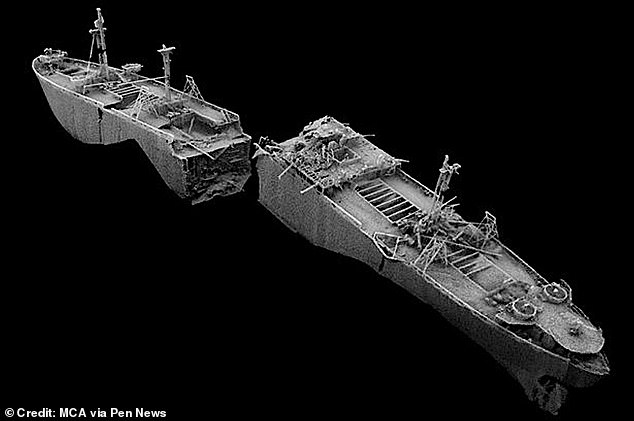
Urgent Alert: Thames’ Bomb-Laden ‘Doomsday Wreck’ Nears Collapse; No-Fly Zone Enforced
Sunken WW2 Ship SS Richard Montgomery Nears Collapse, Threatening Thames Tsunami
A deteriorating shipwreck containing 1,400 tons of unexploded WW2 munitions is inching closer to collapse, raising fears of a potential tsunami in the Thames Estuary. The SS Richard Montgomery, which sank near Sheerness, Kent, in 1944, has shown alarming structural decay in a recent survey, prompting a no-fly zone over the site to mitigate risks.
[Image: The SS Richard Montgomery’s masts protrude above the waterline, a haunting reminder of its deadly cargo.]
Decaying Structure
The wreck, split in two since 1944, is tilting further as its hull weakens. The latest survey revealed the bow has shifted half a meter eastward in two years, while the stern is sagging and may also split. Critical damage was noted in cargo holds, with buckling walls and collapsing decks. Sediment erosion beneath the wreck exacerbates the threat, as parts of the seabed near the ship have sunk by 1.6 meters in a year. Experts warn the bow and stern sections are becoming increasingly unstable, with the gap between them widening due to tidal forces.
[Image: Sonar imagery showing the split wreck and eroded seabed around the SS Richard Montgomery.]
Tsunami Risk
A 1970 study predicted that detonating the ship’s explosives could unleash a 3,000-meter debris column and a five-meter tsunami, flooding nearby coastal towns like Sheerness and Southend. While authorities claim the wreck remains "stable," local leaders are demanding clearer long-term solutions. Daniel Cowan, leader of Southend Council, stressed the need for transparency: “We’d like clarity on the plans to manage this risk permanently.”
No-Fly Zone and Monitoring
The UK Department for Transport (DfT) has imposed a no-fly zone over the wreck, prohibiting civilian flights to prevent accidental disturbances. Officials emphasized the measure is precautionary, with ongoing monitoring by marine engineers. A DfT spokesperson stated, “Our priority is public safety. While the wreck’s condition is stable, we’re acting on expert advice to minimize risks.”
[Image: Aerial view of the Thames Estuary wreck site, marked by buoys and warning signs.]
Historical Context
The SS Richard Montgomery, a US Liberty ship, grounded on a sandbank in 1944 while transporting explosives to Allied forces in Europe. Salvage efforts recovered half its cargo, but the vessel broke apart and sank, leaving 1,400 tons of bombs submerged. For decades, its masts have stood visible above water, with plans now underway to remove them to prevent collapse-triggered explosions.
[Image: Archive photo of the SS Richard Montgomery before its sinking in 1944.]
Ongoing Threats
Despite regular inspections, the wreck’s degradation has accelerated. The forward section’s portside cracks and starboard buckling suggest irreversible damage. Researchers warn that tides and corrosion could eventually cause a collapse, though experts remain divided on the likelihood of a full-scale explosion.
As the SS Richard Montgomery continues to corrode, the race to neutralize its threat persists—a stark reminder of the lingering dangers of wartime relics.
Word count: ~600
(Note: Images are placeholders with captions reflecting key visuals from the original article.)


